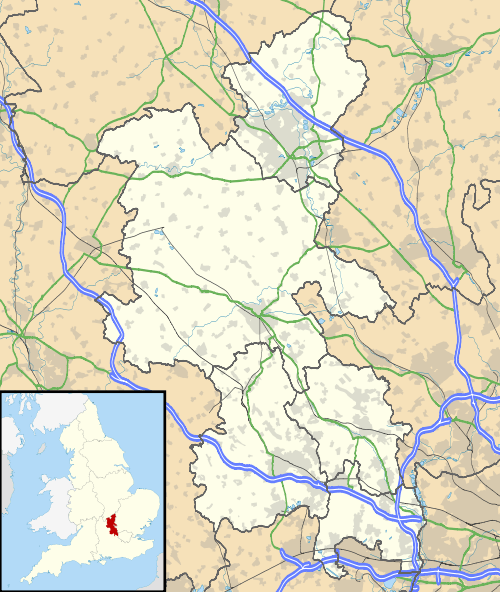Aston Abbotts
| Aston Abbotts | |
 St James the Great parish church |
|
 Aston Abbotts |
|
| Population | 366 (2011 Census including Burston)[1] |
|---|---|
| OS grid reference | SP8420 |
| Civil parish | Aston Abbotts |
| District | Aylesbury Vale |
| Shire county | Buckinghamshire |
| Region | South East |
| Country | England |
| Sovereign state | United Kingdom |
| Post town | Aylesbury |
| Postcode district | HP22 |
| Dialling code | 01296 |
| Police | Thames Valley |
| Fire | Buckinghamshire |
| Ambulance | South Central |
| EU Parliament | South East England |
| UK Parliament | Buckingham |
| Website | Aston Abbotts |
|
|
Coordinates: 51°52′22″N 0°46′13″W / 51.8729°N 0.7702°W
Aston Abbotts or Aston Abbots is a village and civil parish in the Aylesbury Vale district of Buckinghamshire, England. It is about 4 miles (6.4 km) north of Aylesbury and 2.5 miles (4 km) south west of Wing. The parish includes the hamlet of Burston. The 2011 Census recorded a parish population of 366.[1]
Manor
"Aston" is a common toponym in England, derived from the Old English for "eastern estate". The suffix "Abbotts" refers to the former abbey in the village, which until the Dissolution of the Monasteries in the 16th century was the country home of the abbots of St Albans in Hertfordshire. The present house called The Abbey, Aston Abbotts was largely built in the late 18th century and altered in the early 19th century.[2]
Parish church
The Church of England parish church of St James the Great has a late 15th or early 16th century Perpendicular Gothic[3] west tower, but the rest of the building was demolished in 1865 and replaced with a new nave and chancel designed by the Oxford Diocesan Architect G.E. Street and completed in 1866.[4] The church is a Grade II* listed building.[4]
The church tower has a ring of six bells. Anthony Chandler of Drayton Parslow[5] cast the third and fifth bells in the Commonwealth period in 1652.[6] Edward Hall, also of Drayton Parslow,[5] cast the fourth bell in 1739 and the tenor in 1740.[6] John Taylor & Co of Loughborough[5] cast the treble and second bells in 1929.[6]
The explorer James Clark Ross is buried in the churchyard of St James the Great.
Czechoslovak government-in-exile
In the Second World War from 1940 to 1945 Dr Edvard Beneš, the exiled President of Czechoslovakia, stayed at The Abbey in Aston Abbotts. His advisers and secretaries (called his Chancellery) stayed in nearby Wingrave, and his military intelligence staff stayed at nearby Addington. President Beneš gave a bus shelter[7] to the villages of Aston Abbotts and Wingrave in 1944. It is on the A418 road between the two villages.
Amenities
The village has a public house, the Royal Oak.[8] Aston Abbotts had a village shop, but this closed in 2005.[8]
References
- 1 2 "Area: Aston Abbotts (Parish) Key Figures for 2011 Census: Key Statistics". Neighbourhood Statisitics. Office for National Statistics. Retrieved 2 February 2013.
- ↑ "The Abbey". National Heritage List for England. English Heritage. 18 October 1966. Retrieved 21 August 2013.
- ↑ Pevsner 1960, p. 52.
- 1 2 "Church of St James". National Heritage List for England. English Heritage. 18 October 1966. Retrieved 21 August 2013.
- 1 2 3 Dovemaster (31 October 2012). "Bell Founders". Dove's Guide for Church Bell Ringers. Central Council of Church Bell Ringers. Retrieved 21 August 2013.
- 1 2 3 Davies, Peter (19 September 2009). "Aston Abbotts S James". Dove's Guide for Church Bell Ringers. Central Council of Church Bell Ringers. Retrieved 21 August 2013.
- ↑ "Bus shelter with an unusual history".
- 1 2 "Our village – Facilities, Industry and Threats". Aston Abbotts. Retrieved 21 August 2013.
Sources and further reading
- Page, W.H., ed. (1925). "Aston Abbots". A History of the County of Buckingham, Volume 3. Victoria County History. pp. 328–330.
- Pevsner, Nikolaus (1960). Buckinghamshire. The Buildings of England. Harmondsworth: Penguin Books. p. 52. ISBN 0-14-071019-1.
- Rees, Neil (2005). The Secret History of The Czech Connection – The Czechoslovak Government in Exile in London and Buckinghamshire. ISBN 0-9550883-0-5.
External links

Wikimedia Commons has media related to Aston Abbotts. - Czechoslovak Government in Exile Research Society
- Aston Abbotts Chronicle Parish magazine website
- Aston [Abbots] in the Domesday Book
